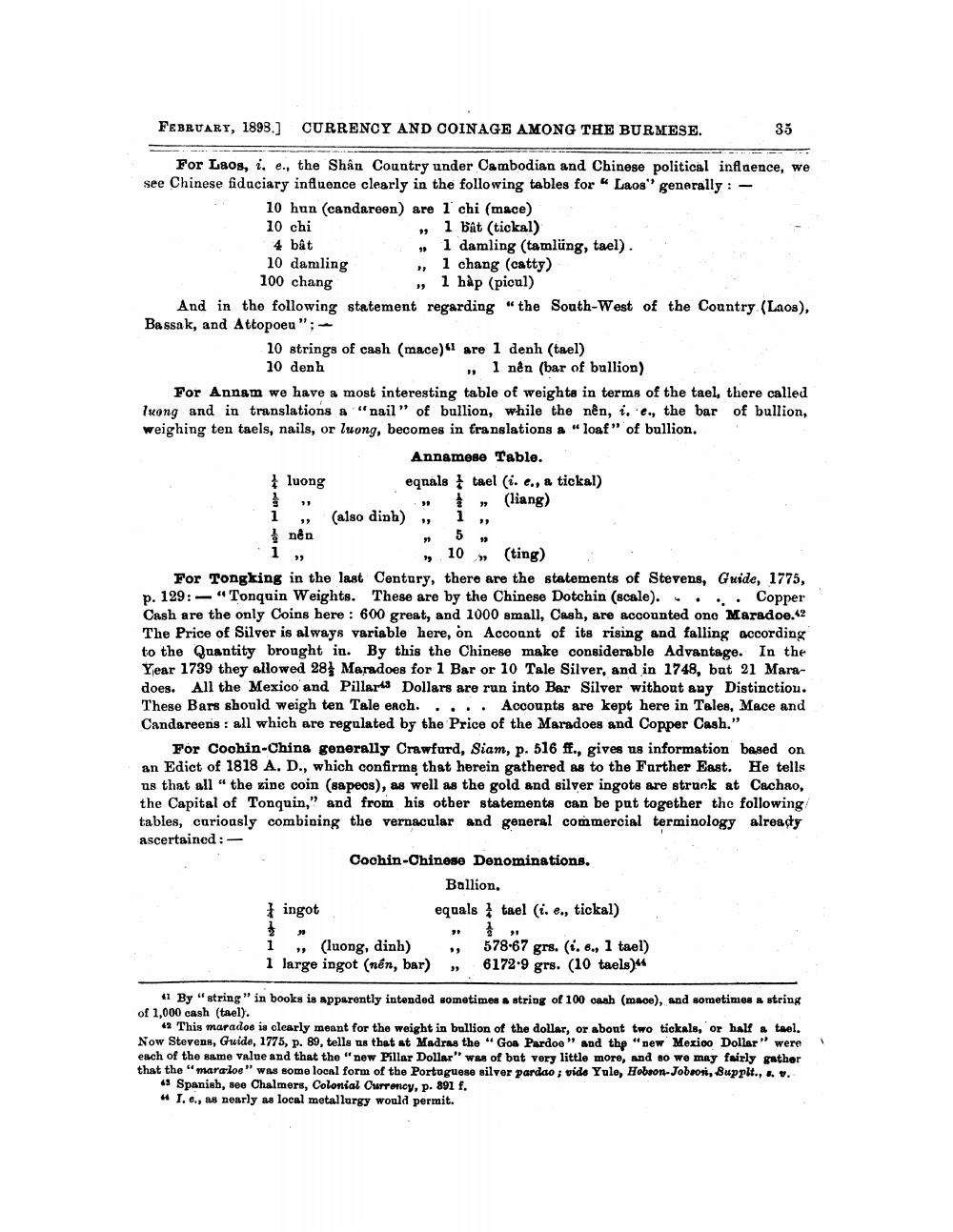________________
FEBRUARY, 1898.] CURRENCY AND COINAGE AMONG THE BURMESE.
35
For Laos, i, e., the Shân Country under Cambodian and Chinese political inflaence, we see Chinese fiduciary influence clearly in the following tables for Laos' generally :
10 hun (candareen) are 1 chi (mace) 10 chi
1 båt (tickal) 4 bât
- 1 damling (tamlüng, tael). 10 damling
.), 1 chang (catty) 100 chang
» 1 hàp (picul) And in the following statement regarding "the South-West of the Country (Laos), Bassak, and Attopoeu";
10 strings of cash (mace)" are 1 denh (tael) 10 den h
» 1 nên (bar of bullion For Annam we have a most interesting table of weights in terms of the tael, there called Inong and in translations a "nail" of bullion, while the nên, i, e., the bar of bullion, weighing ten taels, nails, or luong, becomes in translations a " loaf” of bullion.
Annamese Table. } luong
eqnals tael (i. e., a tickal)
» (liang) „ (also dinh), i nên
, 10 , (ting) For Tongking in the last Century, there are the statements of Stevens, Guide, 1775, p. 129:- "Tonquin Weights. These are by the Chinese Dotchin (scale). ... Copper Cash are the only Coins here : 600 great, and 1000 small, Cash, are accounted one Maradoe. 2 The Price of Silver is always variable here, on Account of its rising and falling according to the Quantity brought in. By this the Chinese make considerable Advantage. In the Year 1739 they allowed 28} Maradoes for 1 Bar or 10 Tale Silver, and in 1748, bat 21 Maradoes. All the Mexico and Pillars Dollars are run into Bar Silver without any Distinctiou. These Bars should weigh ten Tale each.... • Accounts are kept here in Tales, Mace and Candareens : all which are regulated by the Price of the Maradoes and Copper Cash."
For Cochin-China generally Crawfurd, Siam, p. 516 f., gives us information based on an Edict of 1818 A. D., which confirms that herein gathered as to the Farther East. He tells ns that all the zipe coin (sapeos), as well as the gold and silver ingots are struck at Cachao, the Capital of Tonquin," and from his other statements can be put together the following tables, cariously combining the vernacular and general commercial terminology already ascertained :
Cochin-Chinese Denominations,
Ballion. ingot
equals tael (i. e., tickal)
1
»
,,
1 ,, (luong, dinh) 1 large ingot (nén, bar)
578-67 Mrs. (. 6, 1 tael) 6172.9 grs. (10 taels)
41 By "string" in books is apparently intended sometimes a string of 100 cash (mace), and sometimes a string of 1,000 cash (tael).
This marados is clearly meant for the weight in bullion of the dollar, or about two tickals, or half a tool. Now Stevens, Guide, 1775, p. 89, tells us that at Madras the "Goa Pardoo " and the "new Mexioo Dollar" were each of the same value and that the "new Pillar Dollar" was of but very little more, and so we may fairly rather that the "maraloo" was some loonl form of the Portuguese silver pardao ; vide Yulo, Hobson-Jobson, Supplt., ., v.
« Spanish, see Chalmers, Colonial Currency, p. 891 f. 4 1.6., as nearly as local metallurgy would permit.




